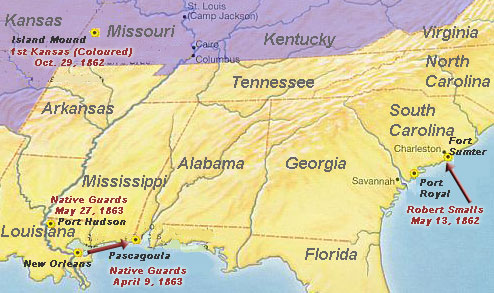
Butler is a city in Bates County, Missouri, United States and is part of the Kansas City metropolitan area. The population was 4,219 at the 2010 census. The county seat of Bates County, the city is named for William Orlando Butler, a noted American military and political figure of the early and mid-19th century. It is located approximately fifty miles south of Kansas City, Missouri on U.S. Route 71-Interstate 49.

The United States Colored Troops (USCT) were regiments in the United States Army composed primarily of African-American (colored) soldiers, although members of other minority groups also served within the units. They were first recruited during the American Civil War, and by the end of the war in 1865, the 175 USCT regiments constituted about one-tenth of the manpower of the Union Army. About 20% of USCT soldiers died, a rate about 35% higher than that of white Union troops. Many USCT soldiers fought with distinction, with 16 receiving the Medal of Honor and numerous others receiving other honors.

The Battle of Baxter Springs, more commonly known as the Baxter Springs Massacre, was a minor battle of the American Civil War fought on October 6, 1863, near the present-day town of Baxter Springs, Kansas.
The Battle of Old Fort Wayne, also known as Maysville, Beattie's Prairie, or Beaty’s Prairie, was an American Civil War battle on October 22, 1862 in Delaware County in what is now eastern Oklahoma.

At the outbreak of the American Civil War in April 1861, Kansas was the newest U.S. state, admitted just months earlier in January. The state had formally rejected slavery by popular vote and vowed to fight on the side of the Union, though ideological divisions with neighboring Missouri, a slave state, had led to violent conflict in previous years and persisted for the duration of the war.

The 1st Cherokee Mounted Rifles was a Confederate States Army regiment which fought in the Indian Territory during the American Civil War. It was formed from the merger of two predecessor units the First Regiment of Cherokee Mounted Rifles, and the Second Regiment of Cherokee Mounted Rifles. The first commander was Col. John Drew, while the second was Stand Watie.

Charles Rainsford Jennison also known as "Doc" Jennison was a member of the anti-slavery faction during Bleeding Kansas, a famous Jayhawker, and a member of the Kansas State Senate in the 1870s. He later served as a Union colonel and as a leader of Jayhawker militias during the American Civil War.
The 1st Kansas Colored Infantry Regiment was an infantry regiment that served in the Union Army during the American Civil War. It was the first black regiment to be organized in a northern state and the first black unit to see combat during the Civil War. At the Battle of Poison Spring, the regiment lost nearly half its number, and suffered the highest losses of any Kansas regiment during the war.
The 1st Kansas Infantry Regiment was an infantry regiment that served in the Union Army during the American Civil War. On August 10, 1861, at the Battle of Wilson's Creek, Missouri, the regiment suffered 106 soldiers killed in action or mortally wounded, one of the highest numbers of fatalities suffered by any Union infantry regiment in a single engagement during the American Civil War.
The 10th Kansas Infantry Regiment served in the Union Army between April 3, 1862, and September 20, 1865, during the American Civil War.
The 11th Kansas Infantry Regiment was an infantry regiment that served in the Union Army during the American Civil War.
The 2nd Kansas Cavalry Regiment was a cavalry regiment that served in the Union Army during the American Civil War.
The 5th Kansas Volunteer Cavalry Regiment was a cavalry regiment that served in the Union Army during the American Civil War.

The 6th Kansas Cavalry Regiment was a cavalry regiment that served in the Union Army during the American Civil War.
The 7th Kansas Cavalry Regiment was a cavalry regiment that served in the Union Army during the American Civil War.
The 9th Kansas Cavalry Regiment was a cavalry regiment that served in the Union Army during the American Civil War.
The 2nd Regiment Colorado Cavalry was a cavalry regiment that served in the Union Army during the American Civil War.

The Battle of Island Mound State Historic Site is located in a rural area of Bates County, Missouri, in the western part of the state. The site was established to preserve the area of the American Civil War battle that took place in October 28–29, 1862 between Union forces and Confederate guerrillas. The battle was significant as the first time African-American troops on the Union side engaged enemy white troops in the Civil War. A correspondent of The New York Times reported on the battle; the headline noted the "desperate bravery" of the African Americans in achieving Union victory.

James Monroe Williams was an American lawyer, soldier, and merchant. He served both as a cavalry and as an infantry officer in the Union Army within the Trans-Mississippi Theater during the American Civil War, and was breveted a brigadier general near the end of the conflict.

7th Missouri Cavalry Regiment was a cavalry unit from Missouri that served in the Union Army during the American Civil War. The regiment was formed on 20 February 1862 by merging Bishop's Cavalry Battalion with some unattached cavalry companies. The regiment fought at Independence, Lone Jack, Prairie Grove and Van Buren in 1862. The unit participated in Frederick Steele's expedition to Little Rock in 1863, fighting at Brownsville, Ashley's Mills, and Bayou Fourche. In 1864, the regiment went on the Camden Expedition and fought at Mount Elba and Marks' Mills. The remaining soldiers were consolidated with the 1st Missouri Volunteer Cavalry Regiment on 22 February 1865.














